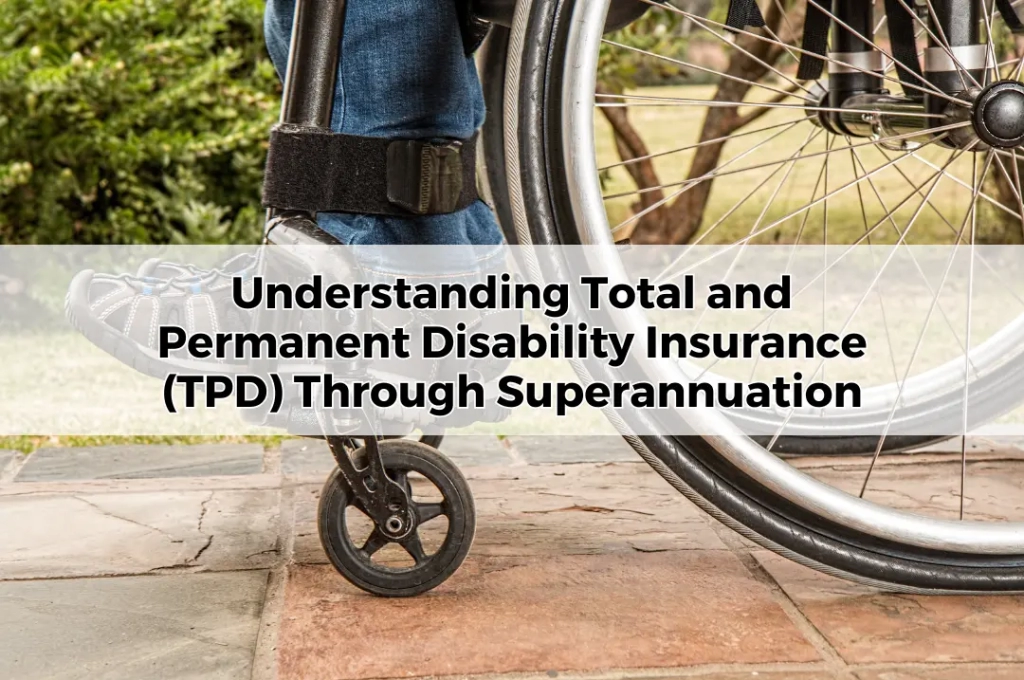Understanding Total and Permanent Disability Insurance (TPD) Through Superannuation
Table of Contents
ToggleTotal and Permanent Disability (TPD) Insurance is a type of coverage that provides financial protection if you become permanently disabled and are unable to work. Many Australians hold TPD insurance through their superannuation fund, which offers a safety net in case of unexpected and life-altering disabilities. Understanding how TPD insurance works within superannuation, its benefits, limitations, and claims process, can help you determine whether this type of coverage is suitable for you.
This article explains TPD insurance in superannuation, its advantages and drawbacks, and the key points to consider when assessing your level of coverage.
What Is TPD Insurance?
TPD insurance pays a lump sum if you suffer an illness or injury that leaves you unable to return to work permanently. The coverage can help cover medical bills, rehabilitation costs, lifestyle adjustments, and provide financial security when earning an income is no longer possible due to a disability.
Within superannuation, TPD insurance generally falls into two categories:
- Own Occupation: Provides cover if you are unable to work in your specific occupation.
- Any Occupation: Provides cover if you are unable to work in any job suited to your training, experience, or education. (Note: Superannuation funds typically offer “Any Occupation” cover, as it meets the eligibility criteria for insurance within super.)
How TPD Insurance Works Through Superannuation
TPD insurance is often included as a default option within superannuation funds. Members usually have the option to increase or reduce their coverage, adjust premiums, or opt-out entirely.
Key Features:
- Premiums Paid from Super Balance: Premiums for TPD insurance are deducted directly from your super balance, rather than out-of-pocket, reducing immediate financial strain.
- Automatic Cover: Many super funds automatically provide TPD insurance when you join, although coverage starts only if you’re over 25 and have a minimum balance of $6,000.
- Coverage Levels: Default TPD coverage levels may be lower than what you would purchase outside super, but you can usually increase the coverage (and premiums) if desired.
Benefits of Holding TPD Insurance Within Superannuation
Holding TPD insurance within superannuation provides several advantages:
- Cost-Effective Premiums: Premiums for TPD insurance within super are often lower due to group-buying arrangements by super funds, making it more affordable than standalone TPD policies.
- Tax-Effective Premium Payment: Since premiums are paid from pre-tax contributions within super, members effectively use pre-tax dollars, which may offer tax benefits.
- No Immediate Out-of-Pocket Costs: Premiums are deducted from the superannuation account balance, reducing the financial burden on monthly cash flow.
- Accessible to Many: TPD insurance is automatically available to members of most super funds, providing coverage without the need for a separate insurance policy.
Limitations of TPD Insurance Through Superannuation
While TPD insurance within super offers convenience and affordability, there are also limitations to consider:
- “Any Occupation” Coverage: Most TPD insurance policies through super only cover you if you cannot work in any occupation that matches your education and experience, which has stricter criteria than “Own Occupation” policies.
- Potential Tax on Benefits: If you withdraw a TPD benefit from your super, it may be subject to tax if taken as a lump sum before reaching preservation age.
- Impact on Retirement Savings: Premium payments reduce your superannuation balance, potentially affecting the growth of your retirement savings over time.
- Limited Coverage: The default coverage provided by super funds may not be sufficient, especially for those with high living expenses, dependents, or substantial debt.
Eligibility and Conditions for TPD Insurance Claims
To successfully claim TPD benefits within superannuation, you generally need to meet specific criteria, including:
- Permanent Disability: You must demonstrate that your disability is permanent and prevents you from working in any suitable occupation.
- Superannuation Fund’s Definition of TPD: Each fund has a specific definition of TPD that must be met to claim a benefit. Generally, this means you are unable to work in any job for which you are reasonably qualified by training or experience.
- Waiting Periods and Medical Evidence: Some super funds require waiting periods and medical evidence, such as reports from multiple healthcare professionals, to substantiate the claim.
The Claims Process for TPD Insurance Through Super
The claims process for TPD insurance within super can be complex and may require assistance from an adviser or claims specialist.
Typical Steps:
- Initial Notification: Notify your super fund about your intention to claim. They will provide the necessary claim forms and documentation requirements.
- Medical Assessments: Submit medical evidence from qualified professionals proving the permanency of your disability and inability to work.
- Assessment by Insurer: The insurer and super fund will assess the claim based on the medical documentation and TPD definitions.
- Approval or Denial: If approved, the benefit is paid into your super account. If denied, you may have the option to appeal or review the decision.
Tax Implications of TPD Payouts in Superannuation
When a TPD benefit is paid, it goes into your super account. If you choose to withdraw the benefit before reaching your preservation age (usually between 55 and 60, depending on your birth year), you may incur taxes on the payout.
- Component Splits: Super balances are typically split into tax-free and taxable components, and the same applies to TPD payouts.
- Tax-Free Component: The tax-free component may apply to a portion of the benefit, particularly if you suffer a disability before reaching preservation age.
- Taxable Component: If taken as a lump sum, the taxable component may incur tax rates of 15% to 30%, depending on age and benefit size. Consulting a tax adviser can help clarify your tax liabilities and options.
Comparing TPD Insurance Inside vs. Outside Super
TPD insurance within superannuation offers convenience, but standalone policies may provide additional benefits. Here’s a comparison:
| FEATURE | TPD INSIDE SUPERANNUATION | TPD OUTSIDE SUPERANNUATION |
|---|---|---|
| Coverage Type | Primarily “Any Occupation” | Option for “Own Occupation” |
| Premiums | Deducted from super balance | Paid out-of-pocket |
| Tax on Premiums | Effectively paid from pre-tax income | Not tax-deductible for personal policies |
| Payout Taxation | May be subject to tax if withdrawn | Generally tax-free |
| Impact on Super Balance | Reduces retirement savings | No impact on super balance |
| Flexibility | Limited benefit levels, restrictive conditions | Customisable benefits, broader coverage options |
Deciding on the Right Level of TPD Coverage
When assessing TPD coverage needs, consider your personal circumstances, financial dependents, and lifestyle. Key factors include:
- Income Replacement Needs: Calculate the amount required to replace your income, pay off debts, and maintain your standard of living.
- Dependents and Obligations: Consider any financial dependents, such as children or elderly parents, and their future needs.
- Existing Coverage Levels: Review the coverage provided within super and assess if it’s enough to meet your financial requirements.
Reviewing and Adjusting TPD Coverage Regularly
It’s essential to periodically review your TPD insurance coverage to ensure it aligns with your current needs. Life events such as marriage, home purchase, or the birth of a child may necessitate changes to your coverage level. Most super funds allow you to adjust TPD coverage, although higher coverage levels will incur higher premiums.
Seeking Professional Advice for TPD Insurance
Navigating TPD insurance within superannuation can be complex, especially if you have specific coverage needs. A qualified financial adviser can assist you by:
- Assessing Coverage Levels: Helping determine the appropriate TPD coverage level for your financial situation.
- Explaining Policy Terms: Breaking down complex terms, conditions, and eligibility criteria.
- Assisting with Claims: Providing guidance throughout the claims process, ensuring you meet all requirements and submit relevant documentation.
Conclusion
Total and Permanent Disability (TPD) insurance within superannuation provides valuable financial protection in the event of a severe disability that prevents you from working. With premiums deducted from your super balance, TPD insurance through super is a cost-effective way to secure coverage, although it’s essential to understand the limitations, such as “Any Occupation” restrictions and potential tax implications on benefits. By reviewing your TPD insurance regularly, understanding the claims process, and seeking professional advice, you can ensure your TPD cover is aligned with your needs, offering peace of mind and financial security if an unexpected disability occurs.









